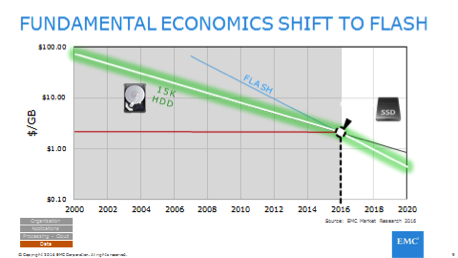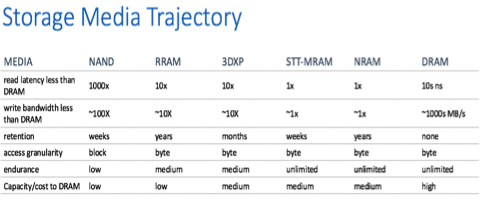2016 is the Year of Flash storage for transactional processing. The transition to flash has been journey for the industry. EMC introduced flash storage media and Fully Automated Storage Tiering (FAST) into our products starting in 2008. Our customers often realized 5x better performance for their transactional workloads with a small amount of flash capacity supplementing high performance hard disk drive technology. Over the past several years it has become more affordable for our customers to move more transaction processing data to flash media. The price for the flash media decreased. In conjunction we introduced new space efficiency software functionality such de-duplication, and compression while enabling more efficient garbage collection processing. In 2016 the cost of flash and high performance hard disk drive technology has intersected. Many of our customers are seeing a 20X performance improvement utilizing flash storage media for their transaction processing. The bad news is with the avalanche of new digital data creation and the exploding use of new data analytics the performance of flash media will not be sufficient for long.

The good news is I believe this is just of the beginning of a transition to a new set of non-volatile media (NVM) that will perform similarly to traditional non-persistent memory (DRAM) with much larger capacities. There are a number of new media types that we believe will become available at enterprise scale by the end of this decade. These new data media types’ will enable new classes of applications capable of processing larger data sets, in near real time. These applications will increase the use of modern in memory data processing and create disruptive business value for early adopter companies.
 This is an exciting time in the IT industry and transitioning your transactional workloads to flash storage is the first important step in this journey. There is still much work to be done to be able to use the new media, and in memory application technologies at enterprise scale. The transition from hard disk drive technology to flash media for transactional processing took about eight years. The transition to the next generation of media at scale will happen much faster, with even greater business impact. EMC has a rich product portfolio capable of leveraging these new media types and a long history of successfully and safely transitioning our customers to new media types, and data processing architectures in a reliable and cost effective manner.
This is an exciting time in the IT industry and transitioning your transactional workloads to flash storage is the first important step in this journey. There is still much work to be done to be able to use the new media, and in memory application technologies at enterprise scale. The transition from hard disk drive technology to flash media for transactional processing took about eight years. The transition to the next generation of media at scale will happen much faster, with even greater business impact. EMC has a rich product portfolio capable of leveraging these new media types and a long history of successfully and safely transitioning our customers to new media types, and data processing architectures in a reliable and cost effective manner.